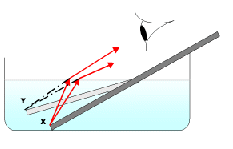You have probably seen how white light produces a spectrum when it passes through a glass block:

This is due to the phenomenon of refraction. When waves pass from one medium to another, the direction and speed of the waves may change. The change may depend on the wavelength or frequency of the light. In the diagram above, the longest wavelength light – red – is refracted the least, and violet light is refracted the most. We can recombine the colours of the spectrum back into white light by passing the light through a second prism. The effect is shown below.

Notice the symmetry in the diagram. The ray emerges from the glass block making the same angle I with the normal as the incident ray makes with the normal on entering the block.
Because refraction makes the direction of light change, things may appear to be exactly where they are not. This is shown in the diagram below, of a pencil in a bowl of water. The end of the pencil at x appears to be at y.

